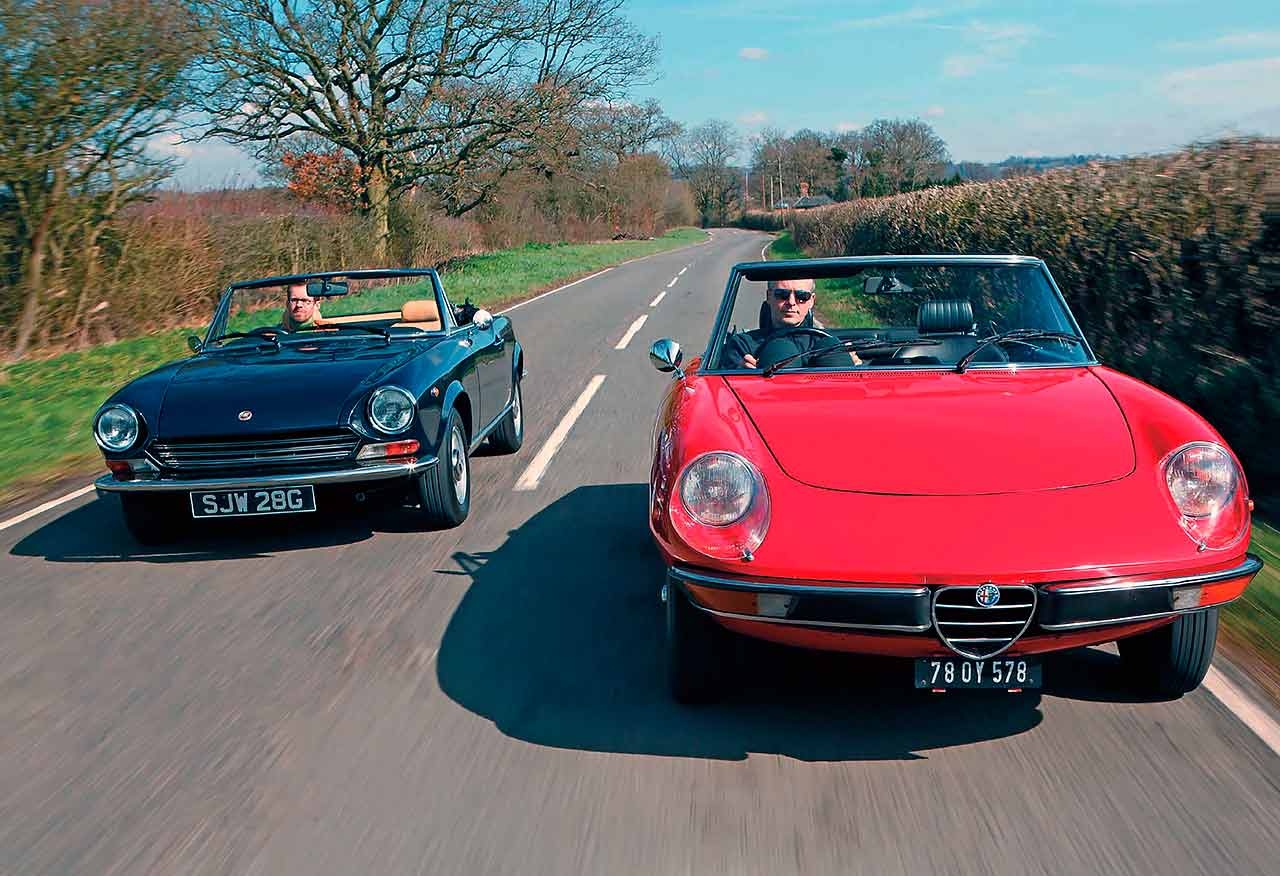
Still sexy at 50. Two of Italy’s finest sports cars were launched a half-century ago, says Malcolm Thorne, but would he rather take home the Fiat or the Alfa Romeo? Photography Tony Baker/LAT/Fiat.
SPIDER SHOOTOUT! CONTINENTAL STYLE… Brilliant 124 takes on chic S2 to find the coolest summer sports car. Fiat takes on Alfa in the battle of the Italian roadsters. Alfa Spider vs. Fiat 124. Malcolm Thorne chooses between two brilliant Italian convertibles.
1966 was an exciting year for devotees of high-performance Italian machinery. Lamborghini grabbed the headlines with its ground-breaking and breathtakingly beautiful Miura, but the tractor maker’s masterpiece is far from being the only Latin supermodel to celebrate its half-century in 2016. Arch-rival Ferrari took the wraps off its quad-cam 275GTB, as well as the 330GTC and the mouth-watering 365 California.
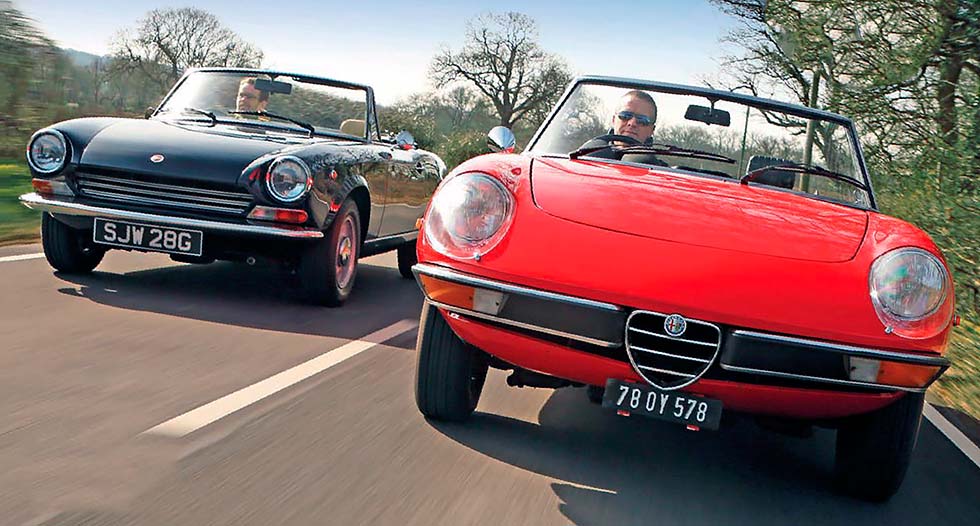
Pininfarina’s radical Ferrari 365 Tre Posti made its debut in Paris in the autumn, rubbing shoulders with Maserati’s new Mexico, while the Trident showed off its exciting new Ghibli at the Turin show in November. That’s quite a selection, yet, for all their showbiz glamour, such exotica was little more than window dressing. It was the stuff of dreams that only the wealthiest of buyers could afford. No, the real heroes of 1966 came from more humble stock.
With a production total of 320,000 units over a combined 46 years, between them Alfa Romeo’s 105 Series Spider and its counterpart from Turin, the Fiat 124 Spider, are the epitome of the classic Latin sports car. With their feisty twin-cam four-pots, five-speed transmissions, fine handling and top-drawer styling from the biggest name in the business – Pininfarina – these endearing soft-tops represent to the Italian motor industry what the MGB and Triumph TR do to our own – but without the antiquated ironmongery.
They also enjoyed remarkably long careers – taking them from modern, forwardthinking designs to national treasure status – which means that there’s no shortage of cars out there today if you’re tempted by a bit of Italian chic.

The Alfa Romeo is by far the better known of our duo in the UK, and not just because of that film appearance. Although based on the 105 Series Giulia that had been introduced in 1962, it wouldn’t be until the Geneva Salon in March 1966 that the new model would replace the outgoing Giulia Spider.
A radical departure from its predecessor’s styling, the silhouette was a productionised version of a theme that had begun with Pininfarina’s Superflow concept. First seen in 1956, by 1959 that car had acquired an open two-seater body previewing many of the lines of the forthcoming Spider – from the heavily sculpted flanks to the long tapering tail. This was a rich period for Alfa show cars, and the Giulietta SS Pininfarina Spider that was unveiled at Geneva in 1961 gave an even stronger clue as to how the forthcoming sports car would look. It would, however, be another five years until the first osso di seppia (or cuttlefish, as the Italians nicknamed the Spider) would roll off the assembly line at Pininfarina’s Grugliasco factory. The final project in which Battista Farina himself played a hand, it was a fitting epitaph to the great man’s talent.
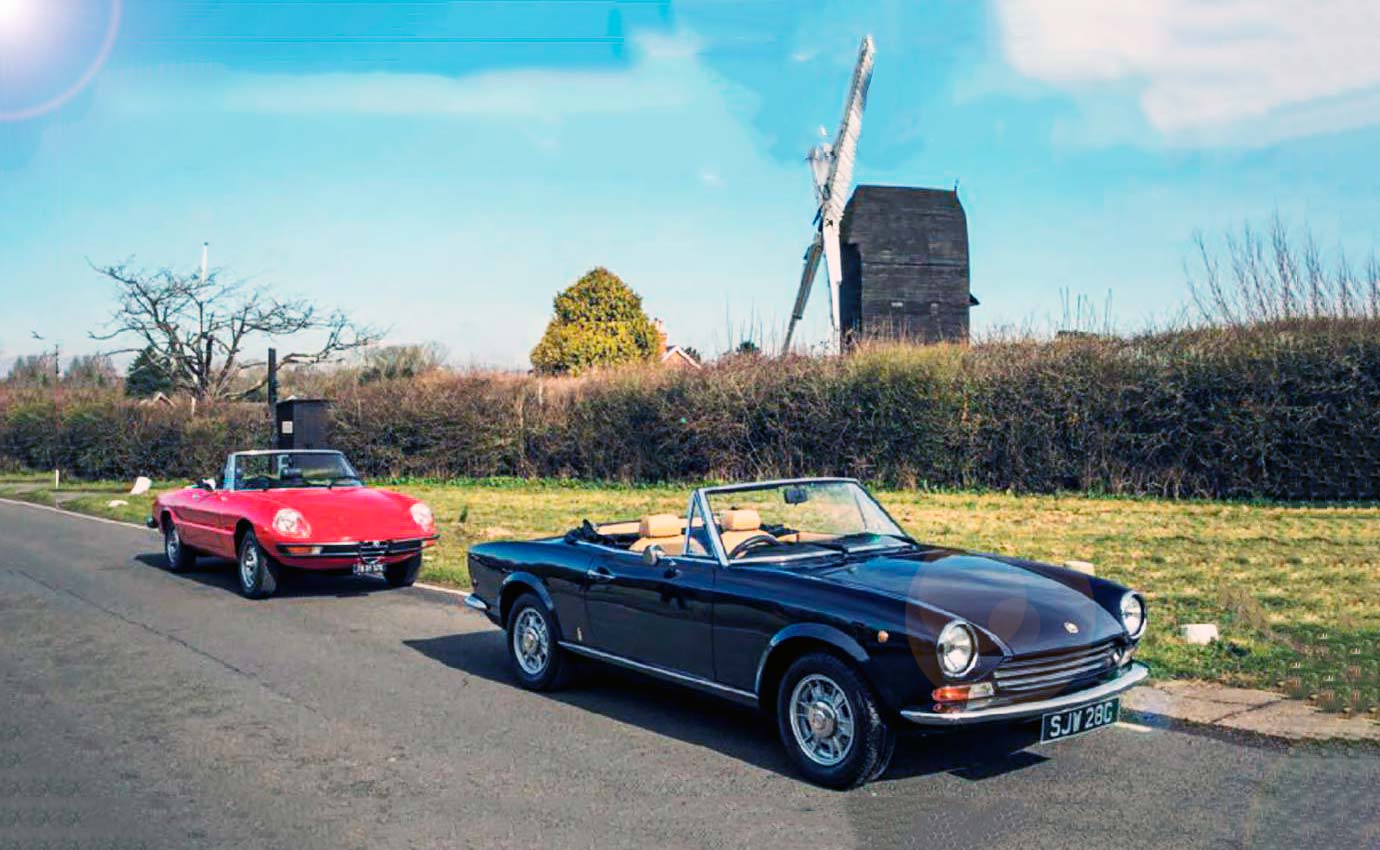
That first incarnation – the Duetto – is the most sought-after (and priciest) variant today, but it was replaced in 1970 by what would go on to become the best-selling and longest-lived version of the classic Spider – the Series 2.
Largely similar from the front, the most obvious difference was the neat squared-off Kamm tail with its more substantial full-width bumper and larger lights. A host of other modifications included an altered windscreen as well as smallerdiameter wheels and tyres. The update may have robbed the Spider of some of its feminine delicacy, but in the forward-thinking 1970s it looked more modern as well as offering significantly increased luggage space. It also provided better protection from the knocks of the ham-fisted idiots who plague the world’s car parks. To me, this is the definitive Alfa Spider.
Inside, the Duetto’s painted metal fascia was replaced by swathes of black plastic, but it was still a delightful place in which to sit. Cast your gaze over the cockpit and every last detail appears to have come under the closest of scrutiny, the designers seemingly intent on creating an environment so bereft of anonymity that nothing escaped their tinkering. From the supplementary gauges angled towards you, plus the heavily hooded speedo and rev counter to the deeply dished wheel, the ambience approaches the baroque in its level of unabashed detailing.
Even the unusual circular pattern of the pedal rubbers transforms them into objects of beauty. Alongside such exuberance, the 124 Spider is almost apologetically understated, although it doesn’t lack finesse or appeal. Also penned and built by Pinin farina, the shape was the work of American architect-turned-car-designer, Tom Tjaarda. The last version, the Spidereuropa, even carried Pininfarina badging, losing the Fiat name from 1983. As with the Alfa, the 124’s outline can be traced back to an earlier show special.
Unlike its Milanese rival, however, the inspiration for the Fiat’s contours had first been previewed on another manufacturer’s chassis – namely, and perhaps surprisingly, Chevrolet. After seeing Tjaarda’s Corvette-based Rondine coupé in Paris, Fiat’s bosses requested a remake for the sporting 2+2 that they were planning as a replacement for the 1500 Cabriolet. Launched at the Turin Salon in November ’1966 and based on a cut-down platform from the 124 saloon, the new Spider would enjoy an impressive 19-year career.
Of the two, the Fiat looks the more modern today, its sharper, chiselled lines placing it firmly at the tail-end of the 1960s. The shape is more generic and less instantly recognisable than the quirky, barrel-sided Alfa, but it’s a superbly slick piece of industrial design. As you walk around it, the deceptively simple styling offers a fine coherence and some gorgeous detailing – the way the waistline kicks up sharply above the sculpted doorhandle recess, the angled rear wings that echo the Ferrari 365 California (also by Tjaarda), not to mention what must be the best hood in the business. Equipped with proper glass rear quarterlights that pivot into the flanks when the top is lowered, it is simplicity itself to operate and wonderfully airy when raised.
The cabin follows a similar theme. Minimalism replaces ornamentation, plain flat surfaces taking the place of the Alfa’s wacky overkill, but it feels classy and sophisticated. That sensation is heightened by the Italian script on the Veglia dials – Benzine, Acqua, Olio – the long chromed gearstick topped by a shiny black ball, and the shallow angle of the wheel. Fiats are obviously mass-market, but this one does a plausible job of persuading you that it’s of noble descent. You wouldn’t need a massive amount of imagination to convince yourself that you’re in a Ferrari 275GTS. Until you fire up the engine, at least.
Aurelio Lampredi’s four-cylinder twin-cam – the world’s first production powerplant to feature belt-driven valvegear – is an excellent unit and, in the carb-fed 1756cc version to be found in ‘our’ car, endows the Fiat with just the right level of performance. It’s quick, willing and fantastic fun, although it lacks the aural thrill of the Alfa from the driver’s seat. In isolation I love it, but it just can’t compete back to back in the sound stakes with the Spider from Milan.
The Fiat makes a pleasant enough noise, but the Alfa’s twin-cam engine, even in 2-litre guise – acknowledged to be the least freerevving but the most flexible version – still eagerly sings its heart out. That wonderfully addictive zing is one of the Alfa Spider’s greatest virtues. There really is nothing mass-market about the way that it ensnares you.
And that is perhaps the best way to describe the whole Alfa Romeo experience. There’s very little about it that feels mainstream. From the floor-hinged pedals to the curiously angled, long-throw gearlever spouting from high up on the centre console, to the dainty little horn pushes on the three spokes of the steering wheel, the Spider feels extraordinary. Rubber floor mats seem utilitarian, but the Alfa can carry off such apparent contradictions with stylish aplomb. It really is an exquisite example of Italian flair.
It goes and stops superbly, too (both cars benefit from discs on all four corners), as well as having a slicker gearchange, but to my mind lacks something of the sporting nature of the Fiat. The Alfa feels narrower and you perch higher than in the Torinese car, which conspires to give a greater sense of roll and inertia when hustled.
In fairness, although ‘our’ Alfa is in beautiful condition, it’s an original, unrestored 41,000-mile example so it would be unfair to expect it to drive as tautly as the 124, which was recently subjected to a painstaking nut-and-bolt rebuild. The consensus seems to be, though, that, when comparing like for like, in the handling stakes the Fiat has a slight edge over its Milanese rival, but it loses out marginally in pure performance terms. Be that as it may, both are a joy to drive, but what are they like to live with?
“I’d go for an S2,” explains Richard Norris of Classic Alfa. “It’s a really good buy in the current market. They are stylish and fast, and look a bargain – especially if you don’t mind left-hand drive, which is about 20% less than right-hand drive. You’d be looking at £20,000 for an excellent right-hooker, compared to £45,000 for a Duetto in similar condition. They are more usable, too, because the 2000 engine has much more torque and the bumpers are more protective than the delicate ones on the roundtail cars.”
Paul de Turris of DTR Sports Cars is equally enthusiastic about the Fiat. “These pre-’1974 chrome bumper cars are the purest, lightest, and by far the prettiest,” he says. “The later cars can be converted to look like the earlier ones, although it’s not quite as simple as you’d imagine. The best model is a 1608cc BS with twin Webers (as fitted to European cars only), or the 1756cc CS cars, which have basically the same engine as the Abarth.
They will rev to the skies and, given regular oil changes, they are indestructible.”
Don’t, however, let the pretty shape or fine engines blind you when looking at a potential purchase. “Bear in mind that body restoration is expensive,” says de Turris. “The 124’s rear arches, for example, are not just a simple replacement – if the outers are rusty, the inners will have already rusted, so you’ll need to replace both, and that takes at least 16-20 hours per side to do correctly.
A typical rebuild is about 7-800 hours – if the car isn’t too rotten to start with. All Spiders will cost roughly the same to rebuild, but chrome-bumper cars can be worth as much as double the value of a later model in the same condition. For pre-’1974 that means currently £10-15,000 in running condition, with nice examples fetching £15-30k. For the best, you’d be looking at £30-40,000.
“Right-hookers are as good to drive if they’ve been converted correctly – about 50-70 of the 2-300 here have been done, 40-50 by us – but it’s only worth it if you won’t consider left-hand drive. Bad conversions may not have reinforcing under the ’screen and steering column. Remember, too, that the cars are not symmetrical – the floor is slightly higher on the offside of post-’1973 models, so if converted you might find that the seat is much too high if you are six foot or over!”
Most UK-market S2 Alfas left the factory with right-hand drive, so that particular issue needn’t apply to the Fiat’s rival, although the same caveats about rot-prone bodywork still apply. “Buy the best restored example you can find,” advises Norris. “Make sure that there are photos of the work and that it was done by a reputable firm. If you buy a project you can easily spend more than the car’s value on it – at least £25k to do the bodywork plus £10k to sort the engine and suspension.
A full rebuild can cost £40,000. Corrosion and poor-quality renovations in the past are the Spider’s biggest enemies. Head-gasket leaks can also be a problem on the S2 and, if there hasn’t been any expense on the front suspension within the past five years, allow for an overhaul of that [about £1000]. It will transform the car.
“The good news is that they are simple to work on, although the dual-circuit braking system on right-hand-drive S2s can be expensive to overhaul and a bit fiddly to bleed afterwards. If you do 5000 miles a year and nothing goes wrong, £300 ought to cover a year’s maintenance. If you owned a good one for five years, I doubt you’d spend more than £4000 in total.”
Both, then, sound like tempting propositions, and de Turris sums them up perfectly: “Customers tend to love their 124s and rarely sell them for something more exotic.” It’s a sentiment that, to my mind, resonates strongly when applied to either car. Why pay more for a temperamental thoroughbred when these two beauties have so much to offer? Whether you belong to the Fiat or Alfa camp, both are effortlessly beguiling and have wonderful charm.
Which would I take home? Aesthetically, I prefer the Fiat. It is gorgeously subtle and, as a further bonus, because the model was never officially offered on these shores, it has the additional cachet of rarity. Many road users will struggle to identify it. Choosing a favourite is a really close call, though, and in one respect at least the Fiat can’t match the Alfa. The Milanese Spider sounds so utterly enchanting, it tugs at even the most sceptical of heartstrings. I’d be happy with either, but I reckon that an Alfa Romeo twin-cam beneath the Fiat’s bonnet would create a near-perfect hybrid.
Thanks to DTR Sports Cars: 020 8645 5050, www.dtrsports.com; Classic Alfa: 020 8688 4443, www.classicalfa.com
Photo and tech
‘FOR ALL THE MIURA’S GLAMOUR, THE REAL HEROES OF ’1966 CAME FROM HUMBLE STOCK’
‘WHICH WOULD I TAKE HOME? AESTHETICALLY, IT’S THE FIAT, BUT THE ALFA SOUNDS SUBLIME’
Clockwise: front is little changed from S1; ’1961 show car previewed styling; ugly rear treatment, but S3 is fine to drive; big bumpers on Spidereuropa; famous badge; neat Kamm tail; pretty steels; doorhandle was also used on later Fiat; South African-spec on ‘our’ car; twin-cam a gem.
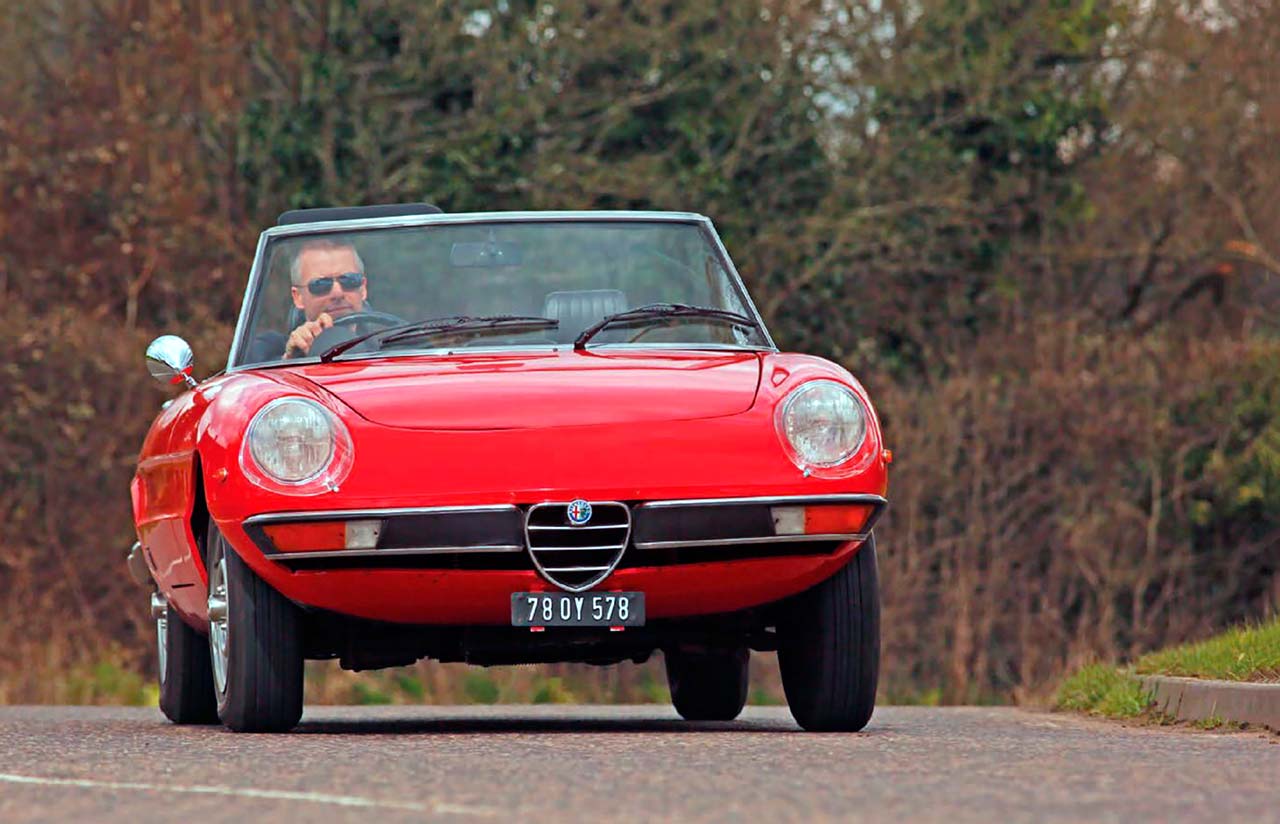
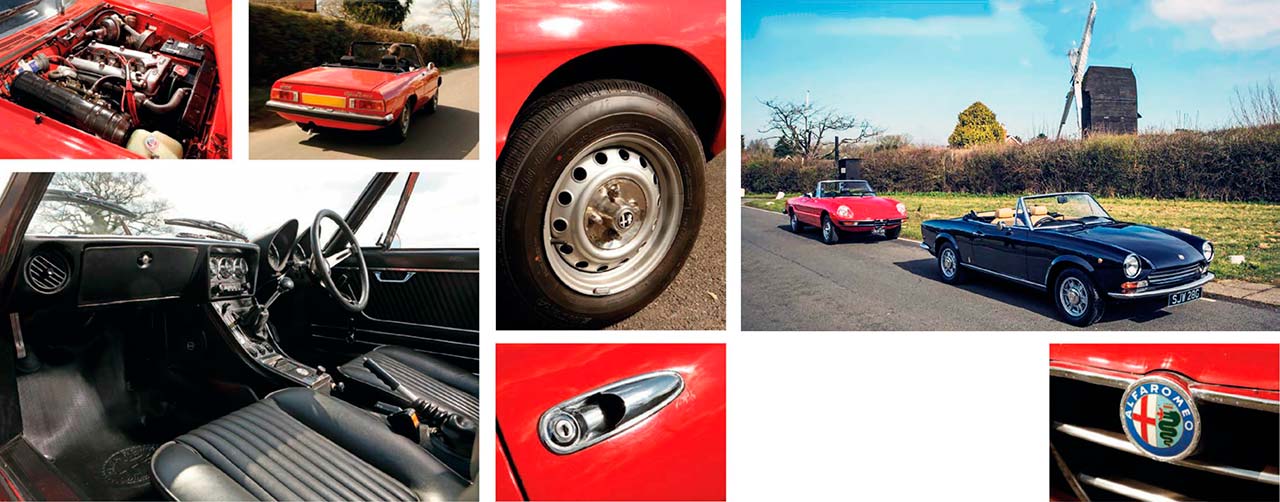
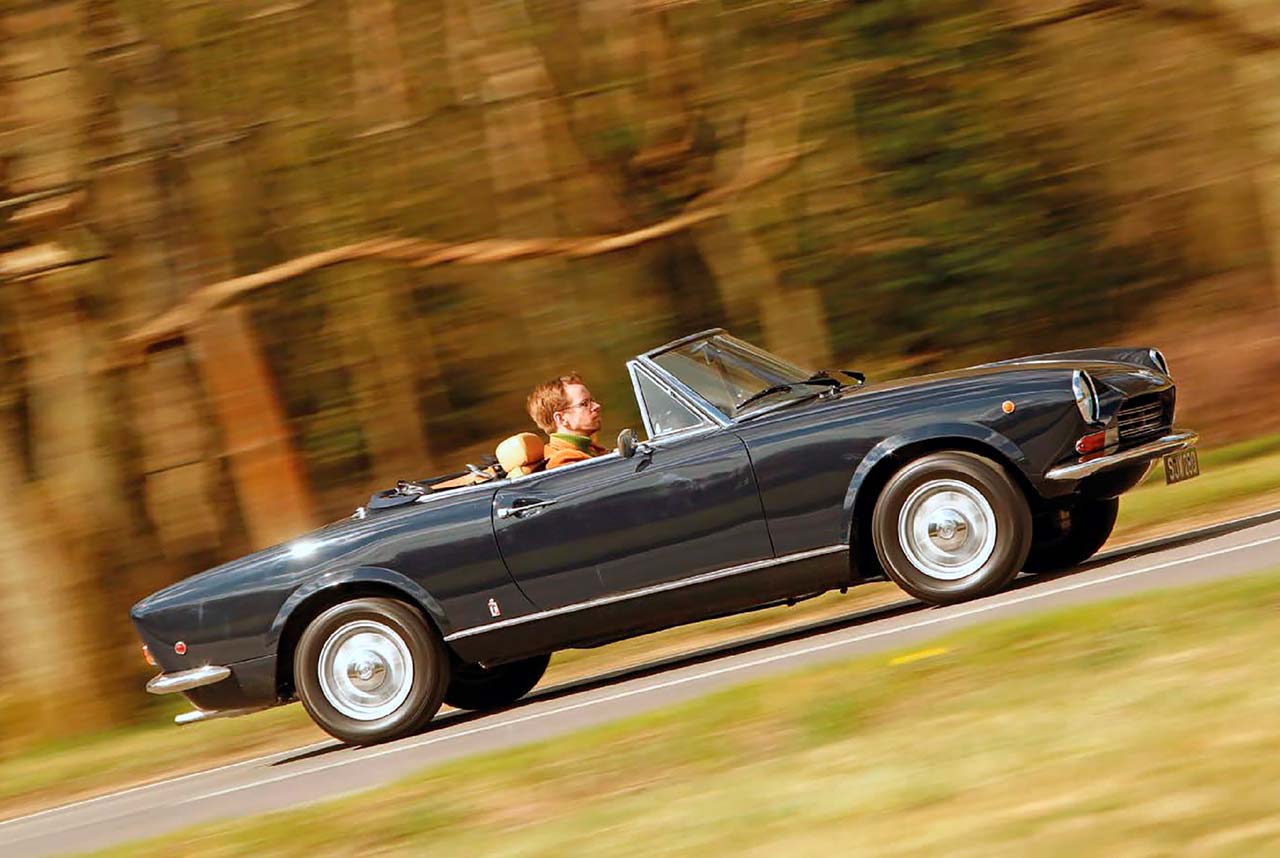
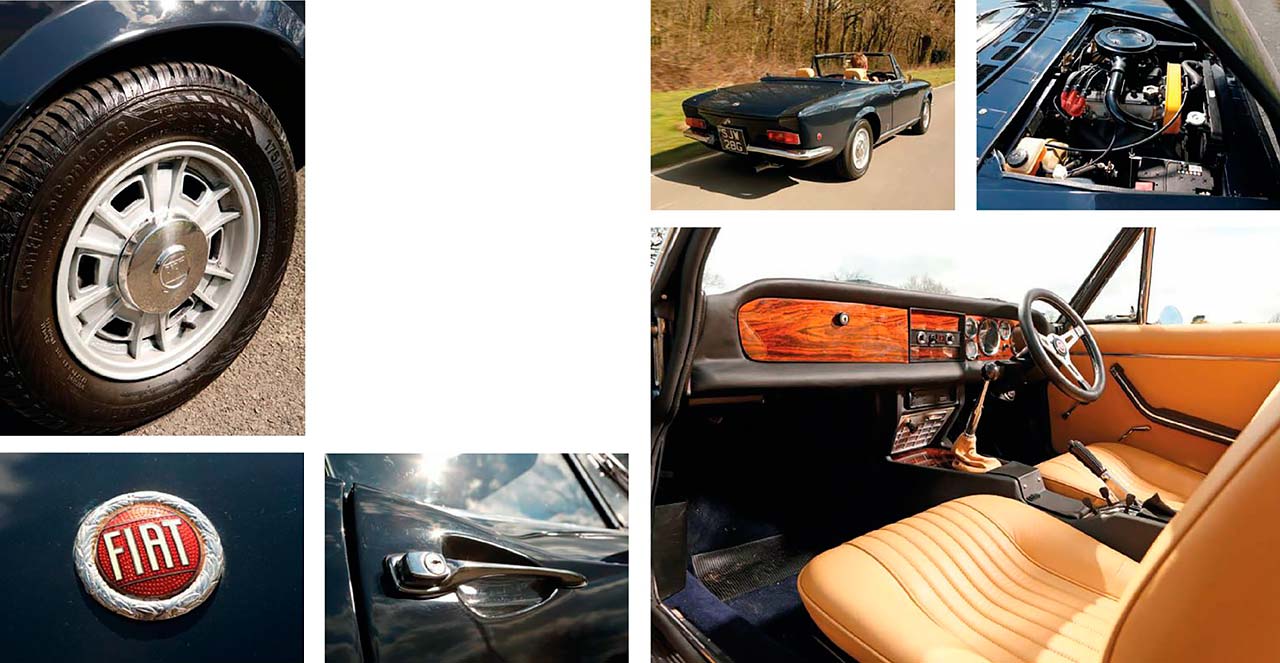
TECHNICAL DATA FILE SPECIFICATIONS ALFA ROMEO SPIDER
Sold/number built 1966-’1993/c120,000
Construction steel monocoque
Engine all-alloy, water-cooled, dohc 1962cc ‘four’, twin Weber, Dell’Orto or Solex carbs
Max power 132bhp @ 5500rpm
Max torque 134lb ft @ 3000rpm
Transmission five-speed manual, driving rear wheels; LSD standard from ’1971
Suspension: front independent by wishbones, anti-roll bar rear live axle, trailing arms, antiroll bar; coil springs, telescopic dampers
Steering recirculating ball
Brakes discs all round, with two servos (RHD)
Length 13ft 6 ½ in (4130mm)
Width 5ft 4 ¼ in (1632mm)
Height 4ft 3in (1290mm)
Weight 2288lb (1038kg)
0-60mph 8.8 secs
Top speed 116mph
Mpg 24
Price new £2949
Price now £12,000-25,000
{module Alfa Romeo Spider}
TECHNICAL DATA FILE SPECIFICATIONS FIAT 124 SPORT SPIDER
Sold/number built 1966-’1985/198,034
Construction steel monocoque
Engine iron-block, alloy-head, dohc 1756cc ‘four’, with single or twin Weber carbs
Max power 118bhp @ 6000rpm
Max torque 113lb ft @ 4000rpm
Transmission five-speed manual, driving rear wheels
Suspension: front double wishbones rear live axle, twin trailing links, Panhard rod; coil springs, telescopic dampers, anti-roll bar f/r
Steering worm and roller
Brakes discs front and rear, with servo
Length 13ft ¼ in (3970mm)
Width 5ft 3 ½ in (1613mm)
Height 4ft 1 ¼ in (1125mm)
Weight 2083lb (947kg)
0-60mph 10.4 secs (2 litre)
Top speed 109mph (2 litre)
Mpg 26
Price new not listed in UK
Price now £10,000-35,000
{module Fiat 124}
Bumper crop
If your funds won’t stretch as far as our featured cars, there are more affordable options. Introduced in 1982, the Series 3 Alfa may have been blighted by ungainly bumpers and spoilers, and a less attractive interior, but it offers all the joy of the S2 for much less outlay: £4-8000 will land you a nice one, and you’ll struggle to notice the difference on the road (although none left the factory with RHD). The last of the line, injected S4 (1990-’1993) was softer – it even had power steering – but was better looking than the S3 and had a galvanised body. A tidy one could be yours for £7-12k.

The Fiat, meanwhile, sprouted impact bumpers in ’1975, but they rank among the least offensive of the species. The Federalised Spider is still an attractive machine, and at £3-10k for a runner and £15- 20k for the best, represents a bargain alongside the earlier models. Power was down against the final chrome-bumper cars, but a 2-litre injected unit from 1980 tackled that. Beware of greater rot post-’1978, thanks to poor-quality Eastern-Bloc steel.
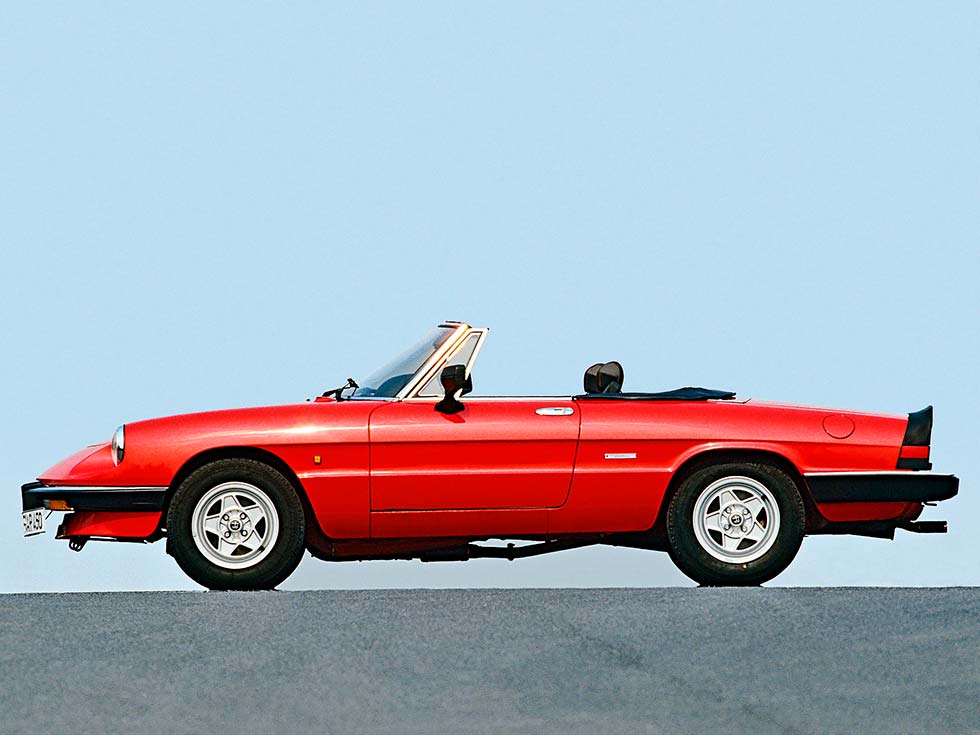
Soft-top revival
Our Latin rivals were reborn in the mid-’90s in the form of the front-drive, Punto-based Barchetta and Tipo-based Alfa Spider. Today they represent a cut-price entry into the world of fresh-air Italian sports cars, as well as decent daily transport.
The Alfa is a larger, heavier machine than the Fiat, the latter offering less straightline urge but a livelier drive – albeit in left-hand-drive only (unlike the Alfa, which came with RHD). Both were highly rated in period, offering pace, neat handling and avant garde styling, although the Alfa was criticised for scuttle shake.
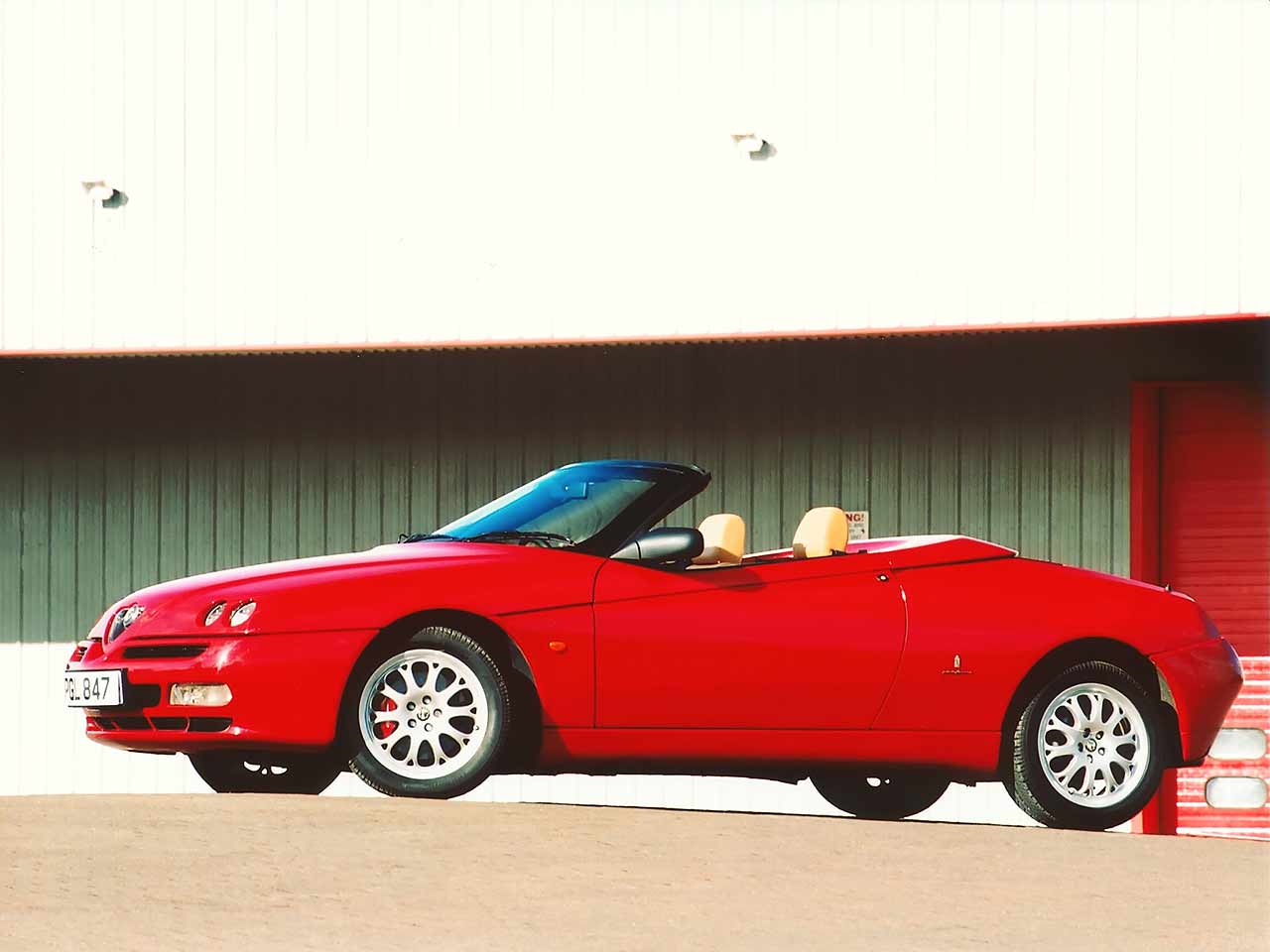
Galvanised bodies mean that rust is less of a problem, but they’re not immune from it. Electrical issues aren’t uncommon, either, and both can suffer from worn rear suspension. Cam variators can be troublesome, too, making them sound like a London taxi.
Decent examples of the two will set you back £3-4000, although a nice V6 Alfa is about £2000 more. The 2-litre Twin Spark Alfa is reckoned to be a better drive, with sharper steering and a sweeter gearchange.
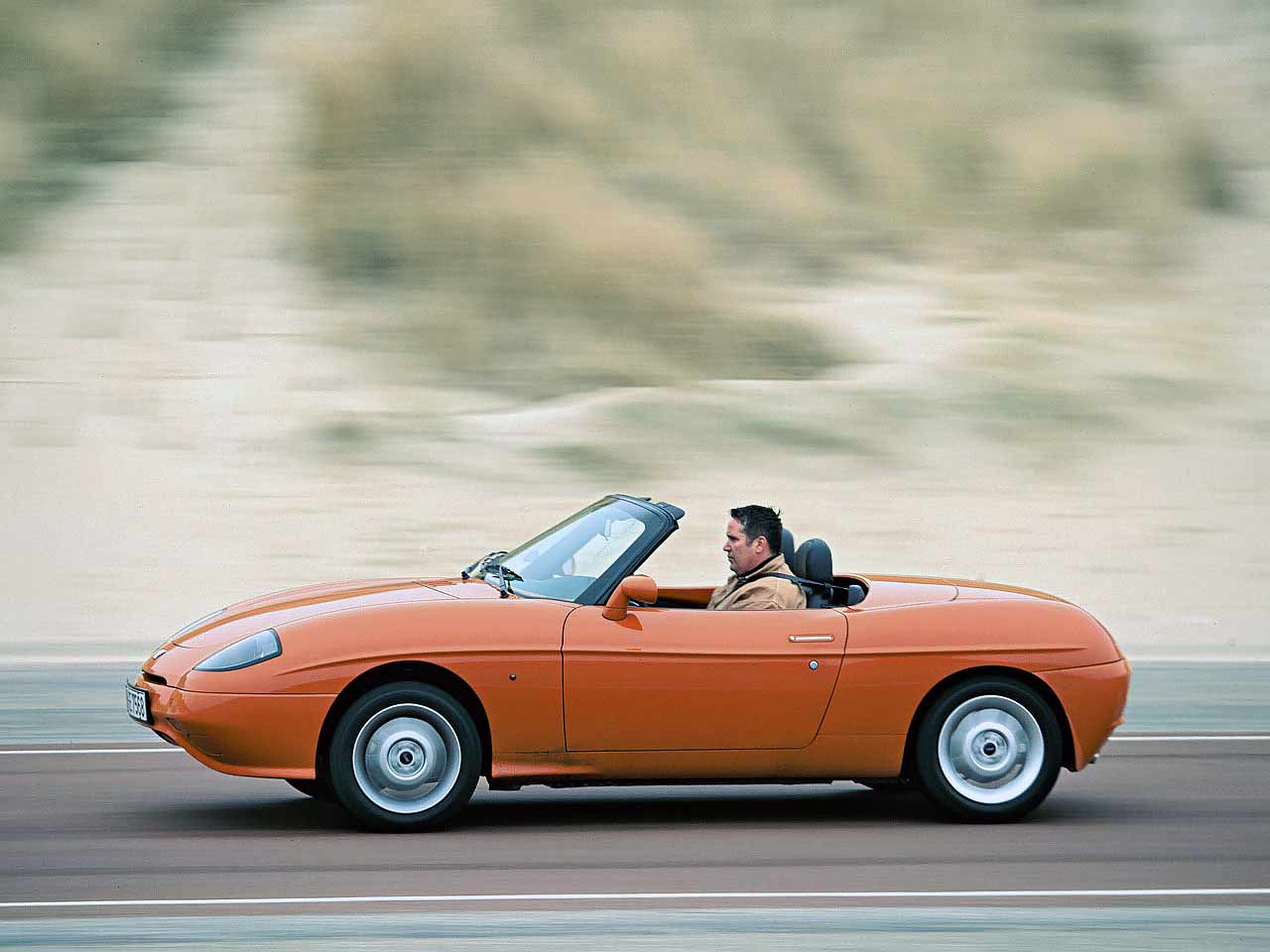
Next generation
In 2012, stories began to circulate of an all-new Alfa Spider based on the fourth-generation Mazda MX-5. Fiat management confirmed that a deal had been signed in May of that year, fuelling excitement among those Alfisti who were less than enamoured by the front-drive Spider. In 2014, though, FCA boss Sergio Marchionne announced a change of tack. All future Alfas, he said, would be made in Italy. A Mazda-based Alfa was not going to happen, but that didn’t mean that it was the end of the line for the project.
Rumours of reviving the Fiat 124 badge began to appear in the press, and then, at the 2015 LA Show, the new car (left) broke cover, a rallyliveried Abarth version following at Geneva in March 2016. Heavily based on the MX-5, the new model is slightly larger than its Japanese cousin and powered by a turbocharged Fiat ‘four’, while its style draws heavily on that of its 1960s forebear.

And Alfa? At present, the Spider name adorns the open version of the mid-engined 4C and there is no talk of a new roadster to join it. But with the Milanese firm returning to rear-drive saloons, we may yet see a modern interpretation of the 105 Spider.
Best of the rest
Alternative soft-tops. Affordable options for the summer. If you’re tempted by an affordable two-seater but you don’t fancy our Latin duo, there are lots of desirable options, as Malcolm Thorne explains. Photography LAT/Tony Baker.
MORGAN 4/4 From £18,000
A veritable antique, even in period, but the combination of pre-war charm and modern running gear holds a certain appeal. In the mid-’60s, ‘modern’ meant a 1498cc Cortina unit, but progressive updates improved the performance over the decade. Surprisingly, perhaps, in 1981 Fiat’s twin-cam found its way under the Morgan’s louvred bonnet.
VW-PORSCHE 914 From £7500
Oddly styled German two-seater trades on the kudos of the Porsche name, although only the rare six-cylinder, 911-engined version was badged as such. Air-cooled 80bhp 1.7-litre VW flat-four (later stretched to 1.8 and then 2 litres) was mounted amidships to optimise handling, but targa top only means that it lacks some of the fresh-air fun of the other cars here.
TRIUMPH TR6 From £12,500
With its seemingly archaic separate-chassis construction and fun, old-fashioned handling, the TR6 may lack the sophistication of our Italian pair. But, thanks to its lusty, fuel-injected 2.5-litre straight-six it more than matches their performance – in a straight line, at least. A bit of a beast, but guaranteed to put a smile on your face. Not the bargain it once was, though.
JENSEN-HEALEY From £5000
The Lotus 907 twin-cam-powered roadster has bland styling compared to our Italian pair, and the cabin is a little plain, but it’s the closest rival here in concept. Early examples suffered from reliability woes, but this accomplished 16-valve 2-litre is quick and handles well. Just 10,500 were built over four years and this underrated, practical design now looks rather appealing.
SUNBEAM ALPINE From £9000
By the time the Alfa and Fiat were launched in 1966, Rootes’ pretty pseudo-American roadster was a bit long in the tooth, but the Series IV of 1964 had its fins clipped back to make it look more modern. The final version boasted a new five-bearing 1725cc lump that improved performance, too.
MGB From £7000
With its overhead-valve, 95bhp 1798cc ‘four’, the venerable B may seem staid after the Alfa and Fiat, but on the road it doesn’t trail that far behind – and is easily uprated to go and handle better. The early cars’ styling is lovely, at least a match for the Italians’ fancy Farina suits, while parts back-up is second to none. A conservative choice (ironically), but don’t dismiss it.
LOTUS ELAN From £19,000
Colin Chapman’s masterpiece runs rings around most things on the road. The Twin Cam engine endowed it with sparkling performance, while independent suspension and four-wheel discs meant it rode and stopped well, too. One of the finest-handling sports cars ever produced: the glassfibre body won’t rust, but the chassis will. Getting pricey, though. See Buyer’s guide.





